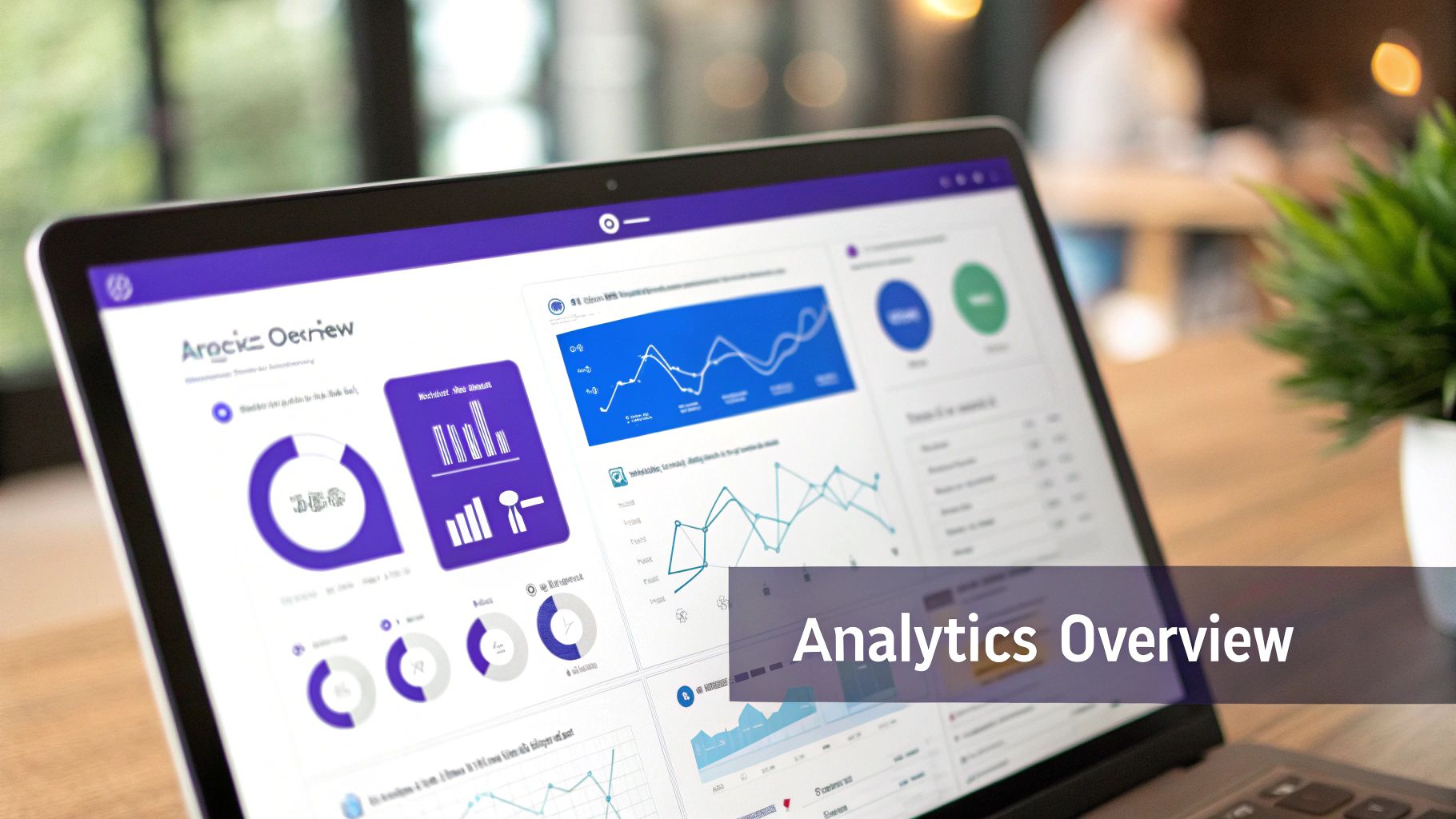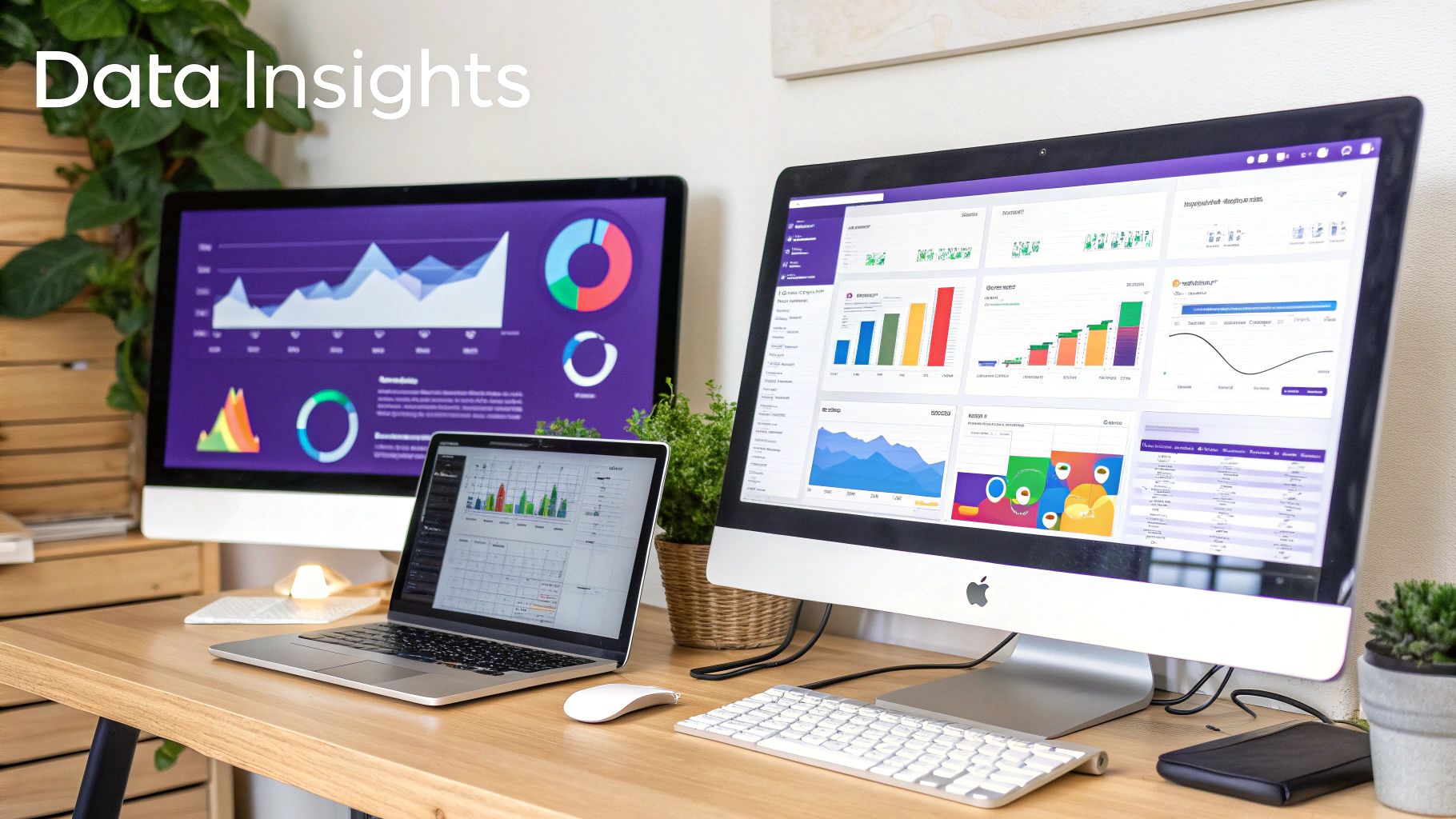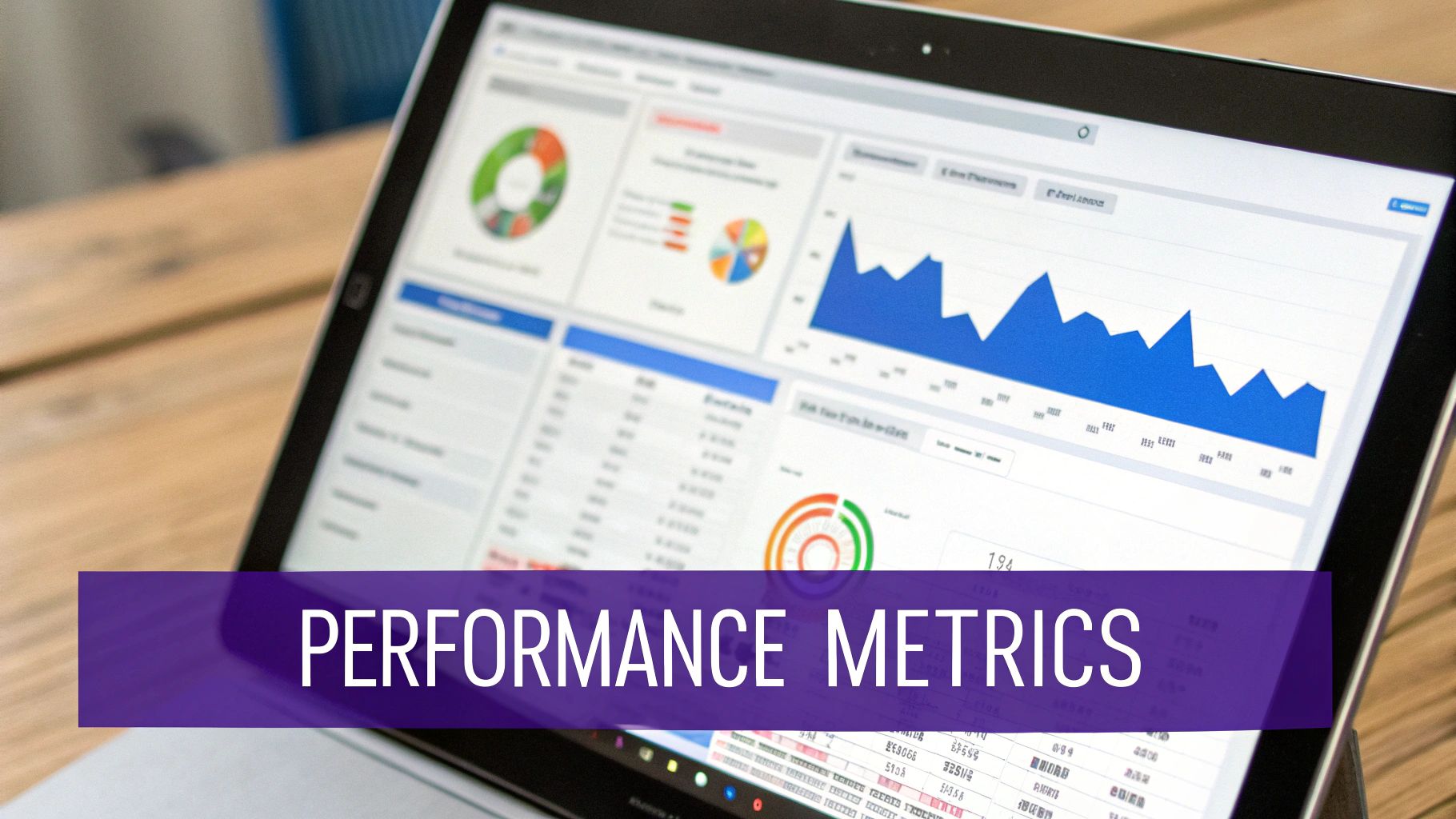Effective Social Media Analytics Reporting Strategies
Discover proven techniques to excel in social media analytics reporting and drive growth.
Posted by
Beyond Vanity Metrics: The Evolution of Social Media Analytics Reporting

Social media has dramatically changed how businesses connect with their audiences. This shift has made robust social media analytics reporting crucial for success. Simple follower counts and likes are no longer sufficient. Businesses now require a more in-depth approach to gleaning valuable insights from their social data.
This means looking beyond vanity metrics and focusing on key performance indicators (KPIs) that directly impact business goals. For instance, a large follower count may seem impressive, but engagement rate and conversion rate truly demonstrate content effectiveness. This evolution in reporting shows the increasing sophistication of social media analytics.
The industry has witnessed a fundamental shift in how businesses analyze social data. Social media analytics reporting has grown into a multi-billion dollar industry. Businesses worldwide now allocate 15-25% of their marketing budgets to social media monitoring and analytics tools. Major platforms like Facebook and Instagram process over 10 billion daily data points globally across metrics like reach, engagement, and conversions.
A 2024 survey indicates that 68% of marketing teams now generate social media reports at least weekly, with 41% utilizing automated tools. The rise of AI-driven analytics has reduced manual reporting time by 30-50% for enterprises, allowing for real-time KPI tracking. Find more statistics here: Learn more about social media analytics. This investment highlights the value of data-driven decisions in social media.
From Monthly Reports to Real-Time Insights
Traditional monthly social media reports are being replaced by more dynamic reporting frequencies. This shift is fueled by the demand for rapid insights and agile responses to trends and audience behavior. Imagine navigating a ship with month-old data – you'd miss critical course corrections. Similarly, relying on monthly reports in the fast-paced social media world can mean lost opportunities.
The Power of Actionable Insights
Successful social media teams understand the importance of focusing on KPIs that drive decisions, not just vanity metrics. They prioritize metrics aligned with specific business goals, such as website traffic, lead generation, and sales.
These teams leverage social listening tools to understand audience sentiment and identify areas for improvement. This focus on actionable insights empowers teams to optimize strategies and achieve measurable results.
By understanding audience preferences, teams can create more targeted and effective campaigns. This ultimately leads to a better return on investment for social media efforts.
Metrics That Matter: Building Comprehensive Social Reports

Creating insightful social media analytics reports hinges on understanding which metrics truly matter. It's about filtering the noise and focusing on the data points that reveal what's driving success. This means looking beyond vanity metrics and delving into the data that reveals what truly resonates with your audience. Choosing the right metrics is the foundation for actionable insights.
Key Metrics for Social Media Analytics Reporting
Effective social media reporting relies on several key metric categories. Let's break them down:
-
Reach: This metric tells you how many unique users see your content, giving you an idea of your potential audience size. Understanding reach helps you gauge the breadth of your content distribution.
-
Engagement: Engagement measures how users interact with your content. This includes likes, comments, shares, and other actions that show audience interest. High engagement suggests your content is resonating and fostering strong audience connections.
-
Conversions: Conversion metrics track how effectively your social media activity drives desired actions, such as website visits, lead generation, or sales. These metrics demonstrate the direct business impact of your social media strategy.
Platform-specific metrics offer a more detailed performance view. For instance, Instagram Story completion rates show how captivating your stories are, while LinkedIn dwell time reveals how well your articles hold audience attention.
It's essential to set meaningful benchmarks to put your performance in context. Are your engagement rates improving? Are conversions meeting targets? Benchmarks provide a reference point for evaluating progress and spotting areas for improvement. Social media reporting should always align with your specific business goals.
The most tracked social media metrics include reach (tracked by 92% of businesses), engagement rate (89%), and conversion data (76%). Demographics, such as gender and age, are also important for tailoring content. Discover more insights about social media analytics. This data helps businesses refine their content for maximum impact.
Platform-Specific Considerations
Different platforms require different metric focuses. Video views and watch time are critical on YouTube, while website clicks and lead generation might be prioritized on LinkedIn. This highlights the need for tailored reporting for each platform.
The following table summarizes essential metrics for various social media platforms:
Essential Social Media Metrics by Platform A comparison of the most important metrics to track across major social media platforms
| Platform | Engagement Metrics | Reach Metrics | Conversion Metrics | Platform-Specific Metrics |
|---|---|---|---|---|
| Likes, Comments, Shares, Reactions | Page Likes, Reach, Impressions | Link Clicks, Conversions | Post Reach, Video Views | |
| Likes, Comments, Shares, Saves | Followers, Reach, Impressions | Link Clicks, Profile Visits | Story Views, Reels Views | |
| Retweets, Likes, Replies, Mentions | Followers, Impressions, Reach | Link Clicks, Website Visits | Tweet Impressions, Hashtag Performance | |
| Likes, Comments, Shares | Followers, Impressions, Post Views | Link Clicks, Lead Generation | Post Clicks, Connection Requests | |
| YouTube | Likes, Comments, Shares, Watch Time | Subscribers, Views, Reach | Link Clicks, Website Visits | Video Views, Watch Time, Average View Duration |
This table highlights how different platforms emphasize various metrics. While engagement is crucial across all, specific metrics like watch time on YouTube and connection requests on LinkedIn become platform-specific indicators of success.
Focusing on the right metrics empowers strategic decision-making and optimized social media performance. This allows you to refine strategies, create more engaging content, and ultimately, achieve your business objectives.
Creating Reporting Cadences That Drive Real-Time Action

Turning raw social media data into actionable strategies hinges on establishing the right reporting rhythm. It's a balancing act between staying informed and avoiding data overload. This means understanding which metrics need daily attention and which are better suited for weekly, monthly, or even quarterly reviews. The right cadence allows you to respond quickly to trends and optimize your social media performance in real-time.
Daily vs. Weekly vs. Monthly Reporting
Some metrics, like engagement on key posts or unexpected dips in reach, require daily monitoring. This allows for immediate action, preventing small issues from becoming major problems. For instance, if a post promoting a limited-time offer underperforms, you can quickly adjust the campaign to maximize its impact.
Weekly reporting offers a broader view of performance trends. This cadence is perfect for tracking metrics like follower growth, overall engagement rates, and website traffic from social media. Analyzing this data weekly helps you fine-tune your content strategy and posting schedule based on emerging patterns.
Monthly reporting gives a high-level overview of your social media activities. It's a great time to evaluate the overall effectiveness of your strategy and track progress toward long-term goals. For example, review your monthly lead generation from social media and adjust your approach for the next month. You might find this helpful: How to improve social media engagement.
Quarterly and Annual Reporting: The Big Picture
Quarterly and annual reports offer invaluable insights into long-term performance. These reports are essential for strategic planning and demonstrating the impact of your social media work. In fact, quarterly and annual social media reports are becoming increasingly important, with 78% of Fortune 500 companies using them to assess year-over-year performance.
These long-term analyses often uncover valuable information. For example, brands that post consistently (3-5 times a week) see 2.5x higher follower retention than irregular posters. The average enterprise-level report now tracks 15-20 KPIs, including metrics like 'dark social' shares (estimated at 20% of total traffic) and branded hashtag performance. Automated reporting tools like SproutSocial have drastically reduced report preparation time, making in-depth analysis more accessible. Find more detailed statistics here: Explore this topic further. This long-term perspective helps you identify areas for sustained growth and measure the overall return on investment (ROI) of your social media strategy.
By establishing a clear reporting cadence, you transform social media analytics from a passive exercise into a powerful driver of real-time action. This ensures your social media strategy stays aligned with your goals and delivers measurable results.
Selecting the Right Tools for Your Analytics Ecosystem

The world of social media analytics platforms can feel overwhelming. With so many options available, how do you choose the right tools to make sense of your data? The key is finding the perfect combination of tools to build a reporting system that meets your specific needs and grows with your organization. This allows you to extract meaningful insights, visualize your data effectively, maximize your ROI, and streamline your reporting process.
Native Platform Analytics vs. Third-Party Solutions
Understanding the difference between native platform analytics and third-party solutions is crucial. Native analytics tools, like Facebook Insights and Twitter Analytics, are built directly into each platform. They offer readily available basic metrics, such as reach, engagement, and follower demographics, giving you a good starting point for understanding your performance.
Third-party tools, such as Sprout Social or HubSpot, consolidate data from multiple platforms into a single dashboard. This allows for cross-platform analysis and more advanced reporting features. Many also offer social listening and competitor analysis capabilities, making them ideal for businesses managing multiple social media accounts.
Key Features to Consider
When evaluating social media analytics reporting tools, focus on features that align with your specific reporting needs. Here are some key factors to consider:
- Cross-Platform Integration: Analyze data from all your social channels in one centralized location for maximum efficiency.
- Customization Options: Create tailored reports and dashboards to provide stakeholders with precisely the information they require.
- Automated Reporting: Automate routine reporting tasks to save valuable time and resources.
- Data Visualization: Transform complex data into clear and compelling charts and graphs that are accessible and engaging.
- Social Listening: Track brand mentions and analyze audience sentiment to gain valuable business insights.
To help illustrate the diverse landscape of available tools, let's look at a comparison of some leading social media analytics platforms.
To help you navigate the selection process, the table below provides a comparison of several leading social media analytics platforms. It highlights key features, pricing, and ideal use cases to help you find the right fit for your needs.
Top Social Media Analytics Reporting Tools Comparison: A detailed comparison of features, pricing, and best use cases for leading analytics platforms.
| Tool | Best For | Key Features | Platforms Supported | Price Range | User Rating (Hypothetical) |
|---|---|---|---|---|---|
| Sprout Social | Businesses & Agencies | Social listening, publishing, analytics | Most major platforms | $99 - $249/month | 4.5/5 |
| HubSpot | Marketing & Sales Teams | CRM integration, marketing automation, analytics | Most major platforms | $450 - $3200/month | 4.0/5 |
| Hootsuite | Social Media Management | Scheduling, analytics, team collaboration | Most major platforms | $99 - $739/month | 4.2/5 |
| Buffer | Small Businesses & Individuals | Scheduling, analytics, basic reporting | Most major platforms | $6 - $99/month | 4.3/5 |
| Brandwatch | Large Enterprises | Consumer intelligence, social listening, advanced analytics | Most major platforms | Custom pricing | 4.6/5 |
As this table demonstrates, each tool offers a unique set of features and pricing options. Choosing the right platform depends on your specific needs and budget.
Choosing Tools Based on Team Size and Reporting Complexity
The ideal tools for your organization depend on your team's size and the complexity of your reporting requirements. Smaller teams with simpler needs may find native platform analytics and free tools sufficient. As your social media presence grows and your reporting needs become more complex, consider adopting more advanced third-party solutions. Agencies managing multiple client accounts, for instance, often rely on robust enterprise-level platforms to handle large data volumes and generate customized client reports.
Combining Solutions for Maximum Insight
Many organizations achieve the best results by combining different tools. Using native platform analytics for daily performance monitoring combined with third-party tools for deeper analysis and customized reporting creates a powerful hybrid approach. This strategy offers both a quick overview and detailed analysis, maximizing efficiency and insight.
Implementing New Tools Effectively
Introducing new tools requires a strategic approach. Begin by defining clear goals for what you want to achieve with the new platform. Provide comprehensive training to ensure your team can effectively use the tool. Regularly evaluate the tool's performance and make adjustments as needed. This proactive process will maximize your ROI and minimize any potential disruptions.
Visualizing Social Data That Demands Attention
Turning complex social media data into engaging visual narratives requires a thoughtful strategy. It's not just about pretty graphs; it's about communicating meaning and prompting action. This involves understanding how visuals are perceived and presenting data in a way that connects with your target audience, from social media managers to C-suite executives.
The Power of Visual Storytelling
Effective social media analytics reporting finds the sweet spot between comprehensive data and clear visuals. Top organizations recognize that too much data can be just as problematic as not enough. Imagine a cluttered room: it’s difficult to find anything useful. A report overflowing with charts and graphs can similarly bury key insights.
Choosing the right chart type is crucial for each metric. Line graphs are ideal for showing trends over time, while bar charts compare different categories effectively. Pie charts illustrate proportions, and scatter plots uncover relationships between variables. Selecting the right visual ensures the data's story is easily grasped.
Dashboard Design: Highlighting Key Insights
Dashboards should highlight key insights and avoid information overload. A well-designed dashboard directs attention to the most important information. This can be achieved by strategically positioning key metrics, using visual hierarchy (like larger fonts for important data), and using white space effectively to avoid clutter. A clean dashboard allows stakeholders to quickly grasp key performance indicators (KPIs) and understand the overall social media landscape.
Using Color, Hierarchy, and Narrative
Color is a powerful tool in data visualization. Consistent color schemes categorize data and link different report sections. However, use color strategically and avoid overwhelming the viewer with too many bright colors. Excessive color can distract and make the report harder to understand. You might be interested in: How to master your social media content calendar.
Hierarchy and narrative structure also enhance clarity in social media analytics reporting. Organizing data logically and using headings and subheadings to guide the reader creates a clear narrative flow. This allows stakeholders to easily follow the data's story and understand the context of each metric. Like a good story, a well-structured report leads the reader through the data in an informative and engaging way.
By using these techniques, you can transform your social media analytics reports from dense data dumps into compelling visual stories that grab attention and inspire action. This ensures your data isn't just seen, but understood and used for strategic decision-making.
Balancing Automation with Human Analysis
Social media analytics reporting is becoming increasingly intricate. To maintain a competitive edge, businesses must find the sweet spot between automated efficiency and the nuanced understanding that only human analysis can deliver. This involves identifying which tasks are best suited for automation and which require a human touch. Finding this balance maximizes both speed and the value of your reports.
Automating the Right Reporting Elements
Automation excels at handling repetitive tasks, freeing up human analysts for more strategic work. It’s like a well-oiled machine: automated processes handle the routine aspects, while skilled analysts focus on quality control and adding personalized insights.
Here are some reporting elements that are perfect for automation:
- Data Aggregation: Automatically pull data from various social platforms like Facebook and Twitter into a central dashboard, saving hours of manual work.
- Report Generation: Automated tools, such as Google Analytics, can quickly generate standardized reports, providing a regular overview of key metrics.
- Scheduled Distribution: Set reports to be automatically delivered to stakeholders at specific times, ensuring everyone has timely access to the data.
Learn more in our article about How to master your marketing automation workflows. This allows analysts to focus on interpreting the data and developing actionable recommendations.
The Indispensable Role of Human Analysis
While automation streamlines many reporting processes, certain elements still demand human expertise. These include:
- Contextual Interpretation: Humans can understand the "why" behind the numbers, connecting data to current events, industry trends, and audience sentiment. For example, a sudden surge in engagement might be linked to a viral trend, requiring a different response than a gradual increase from a successful campaign.
- Strategic Recommendations: Data is only as good as the actions it inspires. Human analysts can identify opportunities, develop data-backed strategies, and provide specific recommendations for improvement.
- Qualitative Data Analysis: Automation struggles with analyzing textual data for sentiment, themes, and emerging trends. Human analysts excel at understanding the nuances of language and context, providing crucial insights.
Building Hybrid Workflows That Scale
Effective social media analytics reporting uses both automation and human analysis. This hybrid approach combines the speed of automation with the depth of human insight.
Here are some strategies for building effective hybrid workflows:
- Automate Data Collection and Reporting: Use tools to automate data gathering and standardized report generation.
- Prioritize Human Analysis for Key Metrics: Focus your analysts' time on the metrics that have the biggest impact on your business objectives.
- Foster Collaboration: Create workflows that encourage communication and feedback between automated systems and your human analysts.
Maintaining Quality as Reporting Needs Grow
As your social media presence expands and your reporting needs become more complex, maintaining report quality is crucial. Use these strategies to ensure quality at scale:
- Data Quality Checks: Regularly review the accuracy and completeness of your automated data.
- Analyst Training and Development: Invest in ongoing training to ensure your analysts are up-to-date on best practices and new analytical techniques.
- Regular Workflow Evaluation: Periodically review your reporting workflows to identify any bottlenecks and uncover opportunities for improvement.
By combining the efficiency of automation with the strategic thinking of human analysts, your social media analytics reporting will become more impactful, leading to data-driven decisions and improved social media performance.
Transforming Reports Into Strategic Business Decisions
The true value of social media analytics reporting isn't about pretty graphs and charts; it's about the actionable insights that drive real business decisions. Think of your reports as a strategic compass, guiding your social media strategy forward, not just a rearview mirror reflecting past performance. This means transforming passive reviews into active drivers of change within your organization.
Connecting Insights to Business Opportunities
Leading organizations use social media analytics reports like a roadmap to identify and capitalize on emerging opportunities. They connect the dots between data insights and specific business objectives. For example, analyzing engagement patterns might reveal a significant interest in a particular product feature, prompting a highly targeted marketing campaign.
Tracking online conversations about your brand can also uncover unmet customer needs. This valuable information can lead to product development improvements or enhancements to your customer service strategies.
Presenting Findings for Action
The way you present your findings significantly influences their impact. Instead of simply showcasing performance metrics, highlight the actionable insights they reveal. For instance, rather than reporting a general increase in website traffic from social media, explain which content drove that traffic and how to replicate that success. This proactive approach encourages data-driven decision-making and translates raw data into tangible results.
Facilitating Productive Conversations
Social media analytics reports should ignite productive conversations within your team. Use these reports as a springboard to discuss challenges, brainstorm innovative solutions, and align strategies across departments. For example, a decline in engagement could spark a discussion about content quality, posting frequency, or audience targeting. These collaborative discussions transform data analysis into problem-solving opportunities.
Translating Metrics into Business Impact
Successful teams translate social media metrics into compelling narratives that demonstrate clear business impact and justify resource allocation. They quantify their achievements by connecting social media activity to tangible outcomes like lead generation, sales, and customer satisfaction. For example, demonstrating how a social media campaign contributed to a 10% increase in leads makes a strong case for continued investment in social media marketing.
Case Studies: Turning Insights into Action
Many organizations have achieved remarkable results by leveraging the power of social media analytics reporting. For instance, a clothing retailer used sentiment analysis to identify negative feedback regarding their online checkout process. By addressing these concerns and streamlining the process, they achieved a 15% increase in online conversions.
Another example involves a software company that discovered, through social listening, that its users were struggling with a specific feature. They created a series of tutorial videos addressing these challenges, resulting in a 20% decrease in support tickets and a 5% increase in customer satisfaction. These case studies showcase the tangible benefits of turning social media analytics insights into strategic action.
Ready to transform your social media reporting from a passive review into a dynamic driver of business decisions? EndorseFlow offers an all-in-one platform to streamline testimonial collection, manage social media content, and demonstrate the ROI of your efforts. Discover how EndorseFlow can empower your social media strategy.